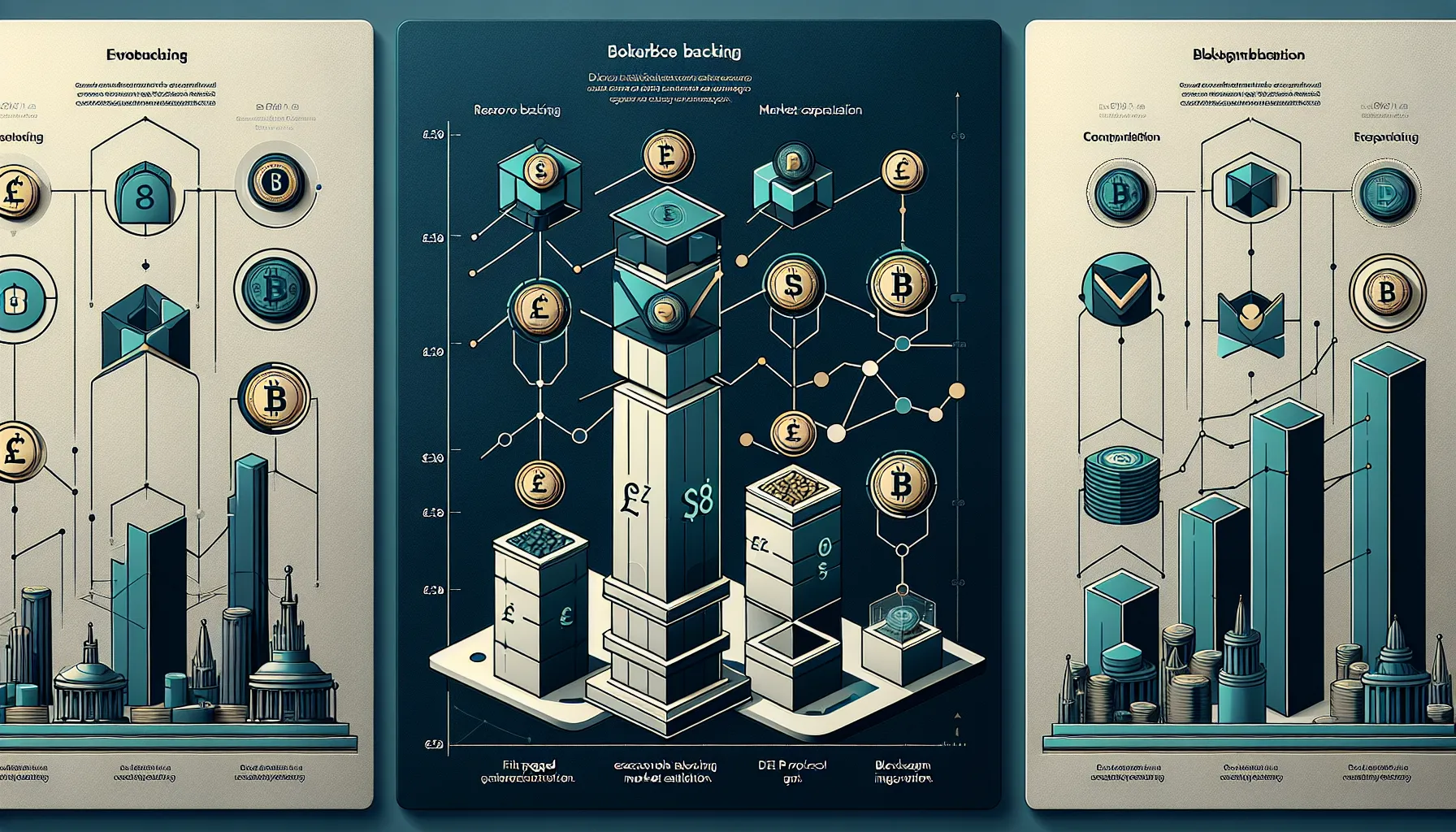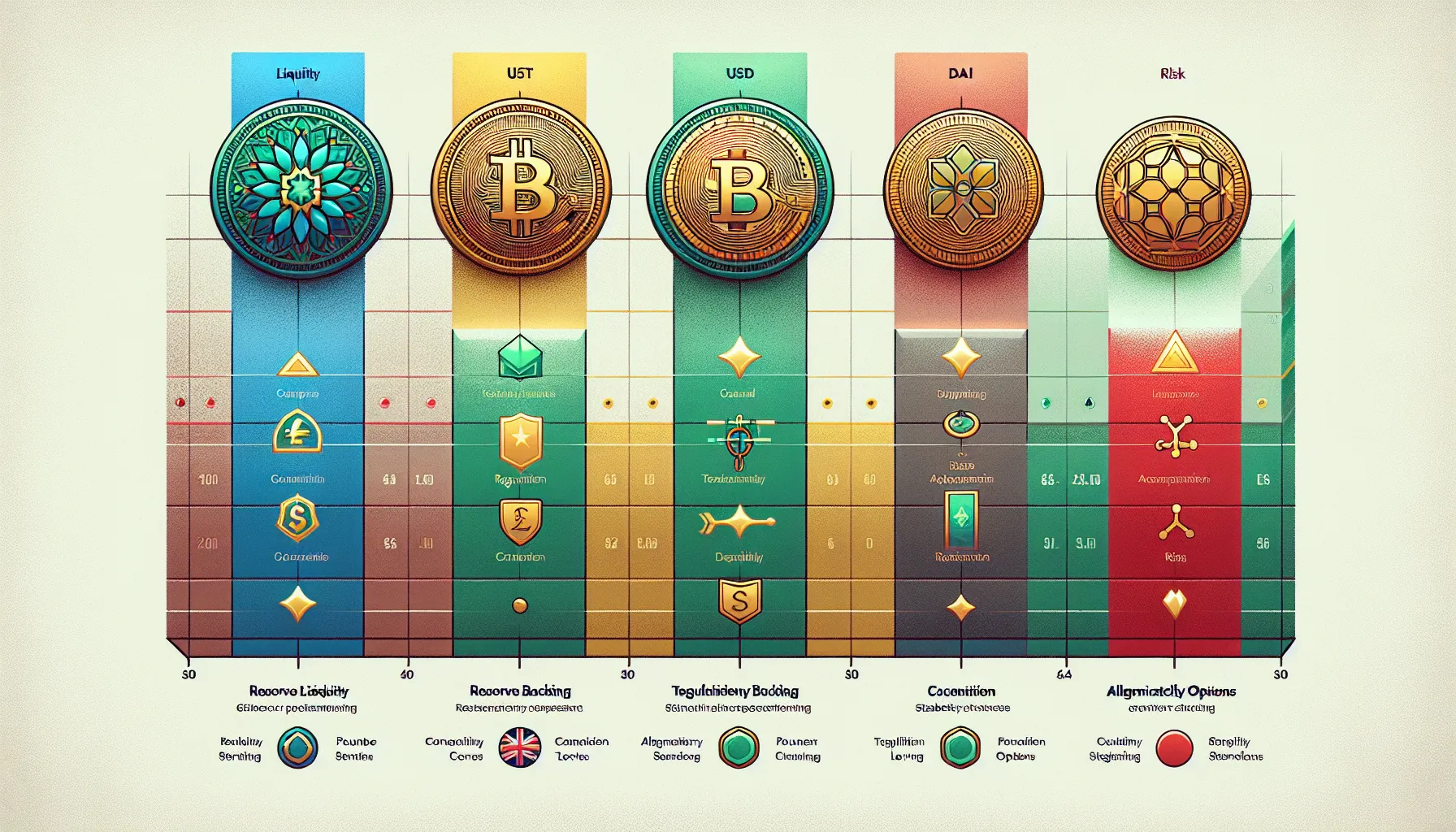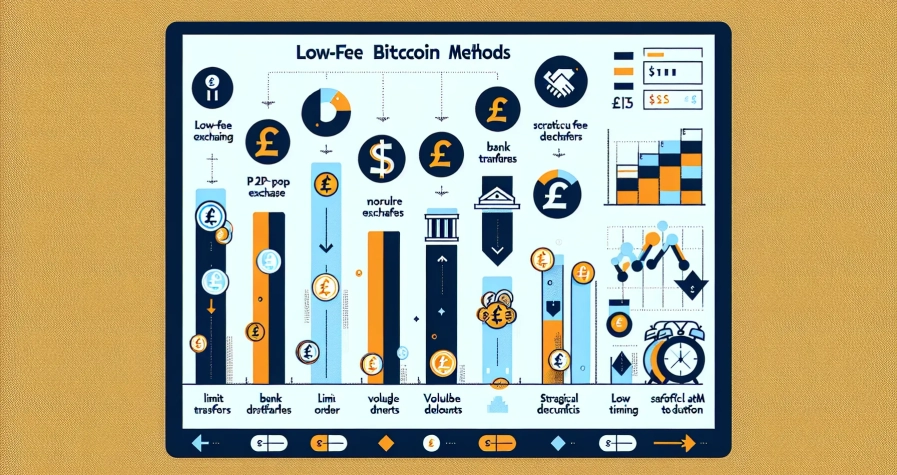Navigating the volatile world of cryptocurrency can feel like walking a tightrope without a safety net. One moment, your portfolio’s soaring: the next, it’s plummeting. That’s precisely where stablecoins come in, digital assets designed to maintain a steady value, typically pegged to a traditional currency like the US dollar or backed by other assets. They’ve become essential tools for traders, investors, and anyone looking to move funds quickly without the wild price swings that define Bitcoin or Ethereum.
But here’s the catch: not all stablecoins are created equal. Some are backed by billions in real-world reserves, audited regularly and regulated tightly. Others rely on algorithms or crypto collateral, introducing complexity and, occasionally, catastrophic failure. With hundreds of millions, sometimes billions, of pounds flowing through these tokens daily, choosing the right stablecoin isn’t just about convenience: it’s about safety, transparency, and trust. This guide breaks down the best stablecoins available today, examining their backing mechanisms, regulatory standing, and real-world performance to help readers make informed decisions.
Key Takeaways
- Stablecoins provide price stability in volatile crypto markets by pegging their value to fiat currencies like the US dollar, making them essential for trading and DeFi applications.
- The best stablecoins for safety prioritise transparent reserve backing, regular independent audits, and strong regulatory compliance to ensure genuine stability.
- USDC leads in transparency and regulatory standing with full backing by cash and US Treasuries, whilst USDT offers superior liquidity despite historical transparency concerns.
- Crypto-backed stablecoins like DAI offer decentralisation and censorship resistance but carry complexity and volatility risks from their cryptocurrency collateral.
- Algorithmic stablecoins have proven catastrophically risky, with high-profile collapses like TerraUSD demonstrating their unreliability during market stress.
- Choosing the right stablecoin depends on individual priorities: traders may favour liquidity, whilst safety-focused users should prioritise regulated, fully collateralised options like USDC or Pax Dollar.
What Are Stablecoins and Why Do They Matter?

Stablecoins are cryptocurrencies engineered to hold a stable value, usually pegged 1:1 to a fiat currency such as the US dollar, British pound, or euro. Unlike traditional cryptocurrencies that experience dramatic price fluctuations, stablecoins aim to provide the speed and borderless nature of blockchain technology whilst maintaining predictable purchasing power.
Their importance in the crypto ecosystem can’t be overstated. Traders use them as safe harbours during market downturns, parking funds in stablecoins instead of converting back to fiat, which often involves fees, delays, and bank complications. They’re also vital for decentralised finance (DeFi) applications, enabling lending, borrowing, and yield farming without exposing users to constant price volatility. Also, stablecoins help international remittances, offering a faster and often cheaper alternative to traditional money transfer services.
The stablecoin market has exploded in recent years, with total market capitalisation regularly exceeding £100 billion. They’ve become the lifeblood of crypto exchanges, representing a significant portion of daily trading volume. But this growth hasn’t come without challenges. High-profile collapses and regulatory scrutiny have put the spotlight on how these tokens maintain their pegs and whether their reserves truly back the circulating supply. Understanding what stablecoins are, and why they matter, is the first step towards using them safely and effectively.
Key Factors for Evaluating Stablecoin Safety
When assessing whether a stablecoin is truly safe and stable, several critical factors come into play. These considerations help separate robust, trustworthy options from riskier alternatives that might appear solid on the surface but carry hidden vulnerabilities.
Collateralisation and Reserve Backing
The foundation of any stablecoin’s stability lies in what backs it. Fiat-backed stablecoins claim to hold reserves, typically cash, cash equivalents, or short-term debt, equal to the number of tokens in circulation. The quality and composition of these reserves matter enormously. A stablecoin backed entirely by cash and government bonds is fundamentally different from one backed by commercial paper or less liquid assets.
Regular, independent audits provide crucial verification. Attestations from reputable accounting firms confirm that reserves exist and match the circulating supply. Without this transparency, users are essentially taking the issuer’s word, a risky proposition in an industry that’s seen its share of fraud and mismanagement. Some stablecoins publish reserve breakdowns monthly or even daily, whilst others operate with far less visibility.
Crypto-backed stablecoins, meanwhile, typically require over-collateralisation, holding more value in crypto assets than the stablecoins issued, to buffer against price volatility. The collateralisation ratio directly impacts safety: higher ratios mean more cushion against market crashes.
Regulatory Compliance and Transparency
Regulatory standing has become increasingly important as governments worldwide turn their attention to stablecoins. Coins issued by regulated entities, holding appropriate licences and submitting to oversight, offer an additional layer of security. These issuers must comply with anti-money laundering (AML) and know-your-customer (KYC) requirements, undergo regular examinations, and maintain certain operational standards.
Transparency extends beyond just reserve attestations. It includes clear terms of service, redemption policies, and communication about how the stablecoin operates. When issuers openly share information and respond promptly to concerns, it builds trust. Conversely, opacity, vague reserve compositions, infrequent updates, or unclear redemption processes, should raise red flags.
Track Record and Market Stability
History matters. How has the stablecoin performed during market stress? Has it maintained its peg during crypto crashes or liquidity crunches? Even brief depegging events can signal underlying weaknesses, whether in reserve management, liquidity provision, or market confidence.
Market stability also relates to liquidity and adoption. Stablecoins with deep liquidity across multiple exchanges and blockchain networks are easier to trade and redeem without slippage. Widespread adoption by exchanges, DeFi protocols, and payment platforms indicates market confidence and reduces the risk of being stuck with an illiquid asset during turbulent times.
Top Fiat-Backed Stablecoins Compared
Fiat-backed stablecoins dominate the market, offering straightforward value propositions: each token is supposedly backed by one unit of fiat currency held in reserve. But their implementations, transparency levels, and regulatory approaches differ significantly.
USDT (Tether): Market Leader with Liquidity Advantages
Tether (USDT) remains the largest stablecoin by market capitalisation and trading volume, often exceeding $80 billion in circulation. Its dominance stems from first-mover advantage and unmatched liquidity, USDT is available on virtually every cryptocurrency exchange and supports numerous blockchain networks, including Ethereum, Tron, and Solana.
From a practical standpoint, USDT’s ubiquity makes it highly convenient. Traders can move between exchanges seamlessly, and its deep liquidity pools mean minimal slippage even on large transactions. It’s the default choice for many institutional and retail traders alike.
But, Tether’s history has been controversial. The company faced questions about its reserves for years, with critics arguing its backing was insufficient or too heavily weighted towards commercial paper rather than cash. Whilst Tether has improved transparency, publishing quarterly reserve breakdowns and securing attestations, it still faces ongoing regulatory scrutiny. The company paid an $18.5 million settlement to New York’s Attorney General in 2021 over reserve misrepresentations, though it admitted no wrongdoing.
Even though these concerns, USDT has maintained its peg remarkably well, even during severe market downturns. For users prioritising liquidity and widespread acceptance, and who are comfortable with the regulatory uncertainties, Tether remains a practical choice. But it’s not the safest option for those prioritising transparency and regulatory clarity.
USDC (USD Coin): Regulatory Focus and Transparency
USD Coin (USDC), issued by Circle (in partnership with Coinbase initially), has positioned itself as the transparent, regulated alternative to Tether. With a market cap typically around $25–35 billion, it’s the second-largest stablecoin and growing steadily.
USDC’s standout feature is its regulatory compliance and transparency. Circle holds money transmitter licences in the US and has pursued a path towards full regulatory approval. The company publishes monthly attestation reports from Grant Thornton, a major accounting firm, detailing reserve composition. These reserves consist entirely of cash and short-term US Treasury bonds, the safest, most liquid assets available.
Circle has also committed to full audits (beyond attestations) and actively engages with regulators. This approach has made USDC the preferred stablecoin for institutions, regulated exchanges, and users who prioritise safety and compliance over maximum liquidity.
USDC is widely supported across DeFi protocols, major exchanges, and payment platforms. Its integration with traditional finance continues to expand, with Circle launching services that bridge USDC with banking systems. For users seeking the best balance of safety, transparency, and usability, USDC is often the top choice.
The main trade-off? Slightly less liquidity than USDT in certain markets and trading pairs, though this gap has narrowed considerably. For most users, USDC’s transparency and regulatory standing outweigh this minor inconvenience.
BUSD and Other Regulated Alternatives
Binance USD (BUSD), issued by Paxos in partnership with Binance, was another leading regulated stablecoin with strong transparency and full backing by cash and US Treasuries. But, in February 2023, the New York Department of Financial Services ordered Paxos to stop minting new BUSD, citing regulatory concerns. Existing BUSD remains redeemable, but its market cap has declined as users migrate to alternatives.
This regulatory action highlights an important point: even well-regulated, fully backed stablecoins face regulatory risk. The landscape is evolving rapidly, and partnerships between crypto platforms and regulated issuers can be disrupted.
Other regulated alternatives include:
- TrueUSD (TUSD): Backed by independently verified USD reserves, with attestations from third-party firms. It offers good transparency but lower liquidity compared to USDT or USDC.
- Pax Dollar (USDP): Issued by Paxos, fully backed and regulated by the New York Department of Financial Services. Known for strong compliance and monthly attestations.
- Gemini Dollar (GUSD): Issued by the Gemini exchange, also regulated in New York with monthly attestations and full USD backing.
These alternatives offer solid safety profiles and transparency, making them suitable for users prioritising regulatory compliance. But, their smaller market caps mean less liquidity and fewer trading pairs on some platforms.
Crypto-Backed Stablecoins: DAI and Decentralised Options
Not all stablecoins rely on fiat reserves held by centralised entities. Crypto-backed stablecoins take a different approach, using cryptocurrency collateral locked in smart contracts to maintain their peg. The most prominent example is DAI, issued by MakerDAO.
DAI is backed by a basket of crypto assets, primarily Ethereum (ETH), but also other tokens like wrapped Bitcoin (WBTC) and even some USDC, locked in MakerDAO’s smart contracts. Users generate DAI by depositing collateral worth significantly more than the DAI they mint, typically at collateralisation ratios of 150% or higher. This over-collateralisation provides a buffer against crypto price volatility.
The appeal of DAI and similar coins lies in decentralisation. There’s no single company controlling the reserves or facing regulatory pressure. The system operates transparently on the blockchain, governed by MakerDAO token holders who vote on parameters like collateralisation ratios and accepted collateral types.
But, this decentralisation comes with trade-offs. DAI’s stability depends on the collateral’s value and the protocol’s ability to maintain adequate collateralisation. During extreme market crashes, if collateral values plummet faster than the system can liquidate under-collateralised positions, the peg could break. MakerDAO has managed this risk well historically, but the 2020 “Black Thursday” crash briefly strained the system when Ethereum’s price dropped over 30% in a day.
Another consideration: DAI’s composition has evolved. To improve stability and scalability, MakerDAO has incorporated significant amounts of USDC as collateral, currently comprising around 40–50% of backing. This makes DAI more stable but partially dependent on a centralised stablecoin, diluting its decentralisation appeal.
For users who value censorship resistance, decentralisation, and transparency, DAI offers a compelling option. It’s widely integrated in DeFi and maintains good liquidity. But it’s more complex than fiat-backed stablecoins and carries unique risks tied to crypto volatility and smart contract security.
Other crypto-backed options include LUSD (Liquity’s stablecoin), which is backed solely by ETH with a minimum 110% collateralisation ratio and offers greater decentralisation than DAI. But, its smaller market cap means lower liquidity.
Algorithmic Stablecoins: Understanding the Risks
Algorithmic stablecoins attempt to maintain their peg without collateral, relying instead on algorithms and supply/demand mechanisms. The idea sounds elegant: smart contracts automatically expand or contract the token supply to keep prices stable. When the price rises above the peg, the protocol mints more tokens: when it falls below, it burns tokens or incentivises holders to remove them from circulation.
In practice, algorithmic stablecoins have proven spectacularly risky. The most infamous example is TerraUSD (UST), which collapsed in May 2022, wiping out nearly $60 billion in value and triggering a broader crypto market crash. UST relied on an arbitrage mechanism involving its sister token, LUNA, to maintain its peg. When confidence broke and redemptions accelerated, the system entered a death spiral, with both UST and LUNA collapsing to near-zero.
This wasn’t an isolated incident. Numerous algorithmic stablecoins have failed to maintain their pegs, often during market stress when stability matters most. The fundamental problem is reflexivity: algorithmic stablecoins rely heavily on market confidence. Once confidence cracks, the mechanisms meant to restore the peg can actually accelerate its collapse.
Some projects continue developing algorithmic or partially algorithmic stablecoins, often with improved mechanisms or hybrid approaches combining algorithms with partial collateralisation. But, these remain experimental and carry significantly higher risk than fully collateralised alternatives.
For anyone prioritising safety and stability, the core promise of stablecoins, algorithmic options are difficult to recommend. The theoretical benefits of capital efficiency and decentralisation haven’t outweighed the demonstrated risks. History has shown that when algorithmic stablecoins fail, they fail catastrophically and quickly, leaving little time for users to exit.
Until the industry develops proven, battle-tested algorithmic mechanisms that can withstand extreme market conditions, users are better served by well-collateralised alternatives, whether fiat-backed or crypto-backed.
Which Stablecoin Is Right for Your Needs?
Selecting the right stablecoin depends on individual priorities, risk tolerance, and use cases. There’s no single “best” option that suits everyone, each leading stablecoin offers different trade-offs.
For users who prioritise maximum liquidity and availability, USDT remains the practical choice. Its presence on virtually every exchange and blockchain network, combined with the deepest liquidity pools, makes it ideal for active traders who need to move quickly between platforms or execute large transactions with minimal slippage. But, these users should be comfortable with Tether’s regulatory uncertainties and historical transparency concerns.
Those who value transparency, regulatory compliance, and safety above all should gravitate towards USDC. Circle’s commitment to full attestations, high-quality reserves (cash and Treasuries), and regulatory engagement make it the safest fiat-backed option for most users. It’s particularly suitable for institutions, long-term holders, and anyone who wants peace of mind about their stablecoin’s backing.
For decentralisation advocates and DeFi users, DAI offers the best combination of censorship resistance and stability. Whilst it’s more complex and carries crypto volatility risks, its transparent on-chain operation and governance by token holders align with crypto’s original ethos. Users comfortable with the technical aspects and willing to accept slightly higher complexity will appreciate DAI’s unique benefits.
Those seeking regulated alternatives beyond the big two might consider Pax Dollar (USDP) or Gemini Dollar (GUSD), both offering strong regulatory standing and transparency, albeit with lower liquidity. These are solid choices for users who want New York regulatory oversight and don’t mind slightly limited trading pairs.
Avoiding algorithmic stablecoins remains prudent for safety-focused users. The catastrophic failures seen in this category make them unsuitable for anyone prioritising stability, even though their theoretical advantages.
Many experienced crypto users diversify across multiple stablecoins, reducing concentration risk. Holding a mix of USDC and DAI, for example, balances regulatory and counterparty risk whilst maintaining good liquidity and access to both centralised and decentralised platforms.
Eventually, the right choice aligns with how one plans to use stablecoins. Active traders might prioritise liquidity: long-term holders might prioritise safety: DeFi enthusiasts might prioritise decentralisation. Understanding these trade-offs enables informed decisions tailored to individual circumstances.
Conclusion
Stablecoins have evolved from a niche crypto innovation to essential infrastructure powering billions in daily transactions. They bridge traditional finance and digital assets, offering stability in a notoriously volatile market. But as this guide demonstrates, not all stablecoins deliver equal safety or stability.
The safest options, USDC, regulated alternatives like Pax Dollar, and decentralised DAI, share common traits: transparent backing, strong collateralisation, and proven track records during market stress. USDT, even though its liquidity advantages, carries more regulatory uncertainty. Algorithmic stablecoins, meanwhile, have repeatedly proven too risky for users prioritising safety.
As the regulatory landscape continues evolving and new stablecoins emerge, the factors outlined here, collateralisation quality, transparency, regulatory compliance, and historical performance, remain the essential criteria for evaluation. The stablecoin that’s right for one user might not suit another, but armed with understanding of how these tokens work and what differentiates them, anyone can make informed choices that align with their priorities.
The stablecoin market will undoubtedly continue maturing, with clearer regulations and improved standards likely ahead. For now, choosing established, transparent, and well-collateralised options remains the wisest path for those seeking genuine stability in the crypto ecosystem.
Frequently Asked Questions
What is the safest stablecoin to use in 2025?
USDC is widely considered the safest stablecoin, backed entirely by cash and short-term US Treasury bonds with monthly attestations from Grant Thornton. Circle’s regulatory compliance and transparency make it ideal for users prioritising safety over maximum liquidity.
Why are stablecoins important for cryptocurrency trading?
Stablecoins provide traders with safe harbours during market downturns, allowing them to park funds without converting to fiat, which involves fees and delays. They maintain predictable value whilst offering the speed and borderless nature of blockchain technology.
Can stablecoins lose their peg and become worthless?
Yes, stablecoins can depeg, particularly algorithmic ones. TerraUSD’s collapse in May 2022 wiped out nearly £60 billion in value. However, well-collateralised stablecoins like USDC and USDT have maintained their pegs remarkably well, even during severe market stress.
What is the difference between fiat-backed and crypto-backed stablecoins?
Fiat-backed stablecoins like USDC hold reserves of cash and government bonds equal to circulating tokens. Crypto-backed stablecoins like DAI use cryptocurrency collateral locked in smart contracts, typically requiring over-collateralisation of 150% or higher to buffer volatility.
Are stablecoins regulated by financial authorities?
Regulation varies by issuer. USDC and Pax Dollar are issued by regulated entities with money transmitter licences and undergo regular oversight. Tether (USDT) faces ongoing regulatory scrutiny, whilst decentralised options like DAI operate without centralised regulatory oversight.
How do I know if a stablecoin’s reserves are legitimate?
Look for regular attestations or audits from reputable accounting firms, published reserve breakdowns showing asset composition, and transparent redemption policies. Stablecoins backed by cash and government bonds offer the highest safety, whilst opacity should raise concerns.









